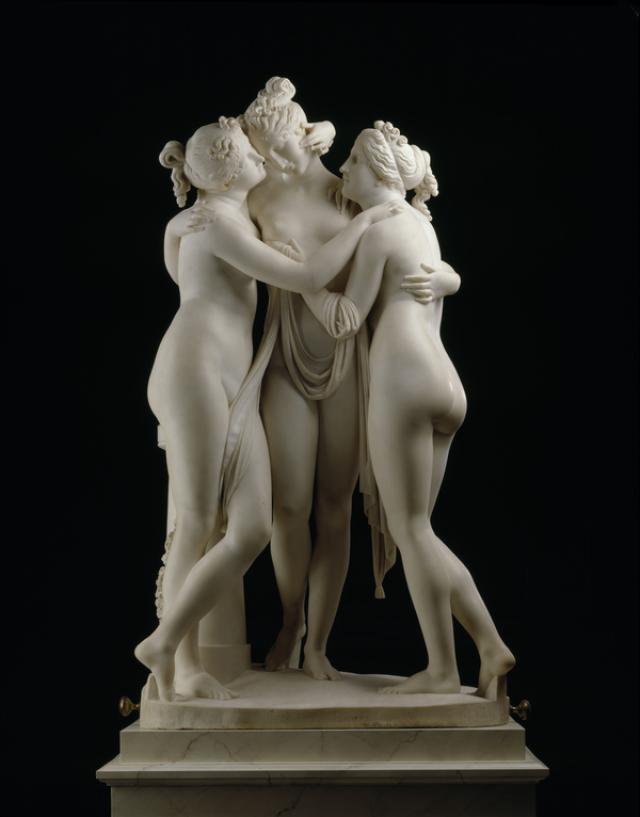Neoclassicism
A European style of art and architecture based on Ancient Greek and Roman models, with particular importance put on simplicity and discipline. It first appeared in the 1750s after the discovery of ancient archaeological sites in Greece and Rome. Such ideals have been revived at various points in history since, and contrast with more decadent and dynamic styles such as the Baroque.

Origins of the Style: A Classical Revival
In the late eighteenth century, a surge of interest in ancient, classical antiquity arose and lasted for nearly a century. Spreading into all aspects of culture, including literature, painting, sculpture, architecture and urban planning, the style became known as Neoclassicism. Prompting this renewal in ancient art was the discovery of buried Roman cities at Herculaneum and Pompei, first excavated in around 1738. The rare findings from these sites were illustrated as engravings in various reports and written about extensively by the hugely influential German historian Johann Joachim Winckelmann. In his Thoughts on the Imitation of Greek Works in Painting and Sculpture (1750), he urged modern artists to emulate the precision of the old order, writing, 'the one way for us to become great, perhaps inimitable, is by imitating the ancients.' His writing played a key role in the development of the Neoclassical style, with other famous publications including Letter About the Discoveries at Herculaneum (1762) and History of Ancient Art (1764).
The Neoclassical style that gradually emerged throughout Europe focussed on clean lines, purity and precision, in stark contrast to the frivolity and excessive decoration of the Baroque and Rococo styles that came before. Another key influence on the Neoclassical style was The Enlightenment, or 'The Age of Reason', with its focus on scientific progress and discovery prompting a wider societal interest in rationalism, logic and reason. Neoclassical artists saw ancient art’s potential to civilise, reform and transform a society already being redesigned in the wake of the Industrial Revolution.
Neoclassical Painting
The painting styles that came to define the Neoclassical era shared a penchant for austere lines, simplified bodies, flattened pictorial space and minimal settings. Colours were generally subdued and introspective while outline and linear design took precedence over atmosphere and light effects. Mythological subjects taken from ancient and medieval literature were popular, such as the poetry of Ossian, the work of Dante and incidents from real history. Biblical and historical scenes were increasingly painted with all the gravity of a classical tragedy, often chosen to convey a moralising message. Artists lifted poses and figure arrangements from engravings of ancient sculptures and vases, draped in the same long, linear patterns of fabric.
One of the first artists to explore the Neoclassical style through painting was the Italian artist Anton Raphael Mengs, whose ambitiously scaled frescoes featuring ordered compositions and soft drapery established Rome as the first centre for the new style. When French painter Jacques-Louis David won the esteemed Prix de Rome in 1774, he came into contact with Mengs’ paintings, infusing the same ideas into his own work. In France, David came to define the peak of the Neoclassical style, painting strong lines, austere settings and artificial light, marking him out as the leader of the movement. Reflecting on the new, Neoclassical order he wrote, 'The artist must be a philosopher and have no other guide except the torch of reason'. David’s subjects often drew comparisons between Roman times and the modern struggle for liberty in France, highlighting his own involvement with the French Revolution.
Similar ideas also began to emerge in the United Kingdom through paintings by Benjamin West, Angelica Kauffman, John Flaxman and Gavin Hamilton. West emphasised moral virtue and bravery through the depiction of historical scenes, such as the enormous painting Alexander III of Scotland Rescued from the Fury of a Stag by the Intrepidity of Colin Fitzgerald, 1786, writing, 'The same truth that guides the pen of the historian should govern the pencil of the artist'.
Sculpture and Architecture
Neoclassical sculpture emerged across Europe alongside painting, with key proponents including Jean-Baptiste Pigalle and his student Jean-Antoine Houdon, along with Antonio Canova and John Flaxman; Canova’s The Three Graces (1815-17), remains one of the most celebrated sculptures of its time, with long, sinewy swathes of fabric and elegant, delicate figures. Many architectural forms were influenced by Andrea Palladio’s designs, with an emphasis on simplicity, geometric structure and the use of Doric columns, a style which spread throughout Europe from the mid-1700s, seen in public buildings, residences and aspects of urban planning as a grid system, taken from classical Roman examples. William Henry Playfair was Scotland’s leading architect of the day, designing Edinburgh’s Royal Scottish Academy and the National Galleries of Scotland buildings in the typical Neoclassical style.
Later Developments
Neoclassicism was a dominant and long-lasting movement leaving behind a substantial legacy; many public buildings across Europe in the style still dominate the urban landscape. Romantic styles of painting gradually superseded the Neoclassical movement, placing greater emphasis on subjectivity, the imagination and the irrational, although some artists continued to combine both styles, such as Jean-Auguste-Dominique Ingres.
Jacques-Louis David’s work was revived in the nineteenth century by several Modernists, including Pablo Picasso and Edvard Munch, while Cindy Sherman appropriated Neoclassical styles for a contemporary audience in many of her self-portraits. Although the style faded out of fashion with the rise of self-expression and emotion, aspects of the Neoclassical style continued to be used by artists and architects working in a Post-modern style in the 1970s and still persist today.











